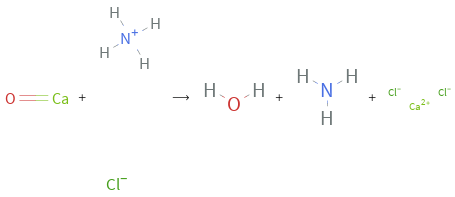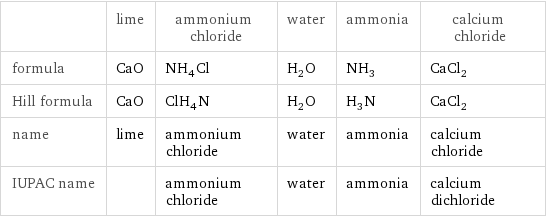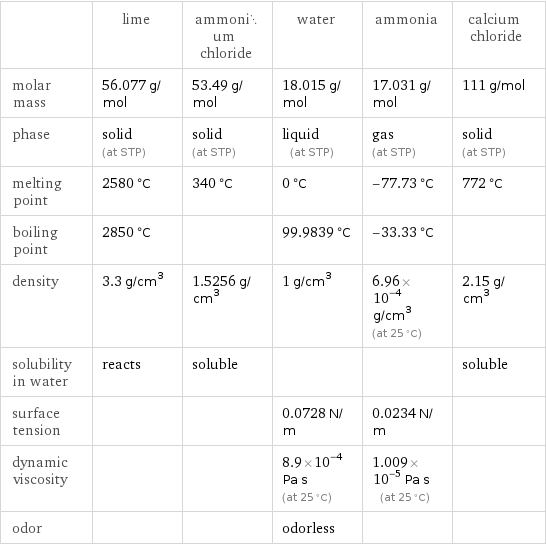Input interpretation

CaO (lime) + NH_4Cl (ammonium chloride) ⟶ H_2O (water) + NH_3 (ammonia) + CaCl_2 (calcium chloride)
Balanced equation

Balance the chemical equation algebraically: CaO + NH_4Cl ⟶ H_2O + NH_3 + CaCl_2 Add stoichiometric coefficients, c_i, to the reactants and products: c_1 CaO + c_2 NH_4Cl ⟶ c_3 H_2O + c_4 NH_3 + c_5 CaCl_2 Set the number of atoms in the reactants equal to the number of atoms in the products for Ca, O, Cl, H and N: Ca: | c_1 = c_5 O: | c_1 = c_3 Cl: | c_2 = 2 c_5 H: | 4 c_2 = 2 c_3 + 3 c_4 N: | c_2 = c_4 Since the coefficients are relative quantities and underdetermined, choose a coefficient to set arbitrarily. To keep the coefficients small, the arbitrary value is ordinarily one. For instance, set c_1 = 1 and solve the system of equations for the remaining coefficients: c_1 = 1 c_2 = 2 c_3 = 1 c_4 = 2 c_5 = 1 Substitute the coefficients into the chemical reaction to obtain the balanced equation: Answer: | | CaO + 2 NH_4Cl ⟶ H_2O + 2 NH_3 + CaCl_2
Structures

+ ⟶ + +
Names

lime + ammonium chloride ⟶ water + ammonia + calcium chloride
Reaction thermodynamics
Enthalpy

| lime | ammonium chloride | water | ammonia | calcium chloride molecular enthalpy | -634.9 kJ/mol | -314.4 kJ/mol | -285.8 kJ/mol | -45.9 kJ/mol | -795.4 kJ/mol total enthalpy | -634.9 kJ/mol | -628.8 kJ/mol | -285.8 kJ/mol | -91.8 kJ/mol | -795.4 kJ/mol | H_initial = -1264 kJ/mol | | H_final = -1173 kJ/mol | | ΔH_rxn^0 | -1173 kJ/mol - -1264 kJ/mol = 90.67 kJ/mol (endothermic) | | | |
Gibbs free energy

| lime | ammonium chloride | water | ammonia | calcium chloride molecular free energy | -603.3 kJ/mol | -202.9 kJ/mol | -237.1 kJ/mol | -16.4 kJ/mol | -748.8 kJ/mol total free energy | -603.3 kJ/mol | -405.8 kJ/mol | -237.1 kJ/mol | -32.8 kJ/mol | -748.8 kJ/mol | G_initial = -1009 kJ/mol | | G_final = -1019 kJ/mol | | ΔG_rxn^0 | -1019 kJ/mol - -1009 kJ/mol = -9.6 kJ/mol (exergonic) | | | |
Equilibrium constant
![Construct the equilibrium constant, K, expression for: CaO + NH_4Cl ⟶ H_2O + NH_3 + CaCl_2 Plan: • Balance the chemical equation. • Determine the stoichiometric numbers. • Assemble the activity expression for each chemical species. • Use the activity expressions to build the equilibrium constant expression. Write the balanced chemical equation: CaO + 2 NH_4Cl ⟶ H_2O + 2 NH_3 + CaCl_2 Assign stoichiometric numbers, ν_i, using the stoichiometric coefficients, c_i, from the balanced chemical equation in the following manner: ν_i = -c_i for reactants and ν_i = c_i for products: chemical species | c_i | ν_i CaO | 1 | -1 NH_4Cl | 2 | -2 H_2O | 1 | 1 NH_3 | 2 | 2 CaCl_2 | 1 | 1 Assemble the activity expressions accounting for the state of matter and ν_i: chemical species | c_i | ν_i | activity expression CaO | 1 | -1 | ([CaO])^(-1) NH_4Cl | 2 | -2 | ([NH4Cl])^(-2) H_2O | 1 | 1 | [H2O] NH_3 | 2 | 2 | ([NH3])^2 CaCl_2 | 1 | 1 | [CaCl2] The equilibrium constant symbol in the concentration basis is: K_c Mulitply the activity expressions to arrive at the K_c expression: Answer: | | K_c = ([CaO])^(-1) ([NH4Cl])^(-2) [H2O] ([NH3])^2 [CaCl2] = ([H2O] ([NH3])^2 [CaCl2])/([CaO] ([NH4Cl])^2)](../image_source/21f971ce30e5a9a0e586a91234ded7bc.png)
Construct the equilibrium constant, K, expression for: CaO + NH_4Cl ⟶ H_2O + NH_3 + CaCl_2 Plan: • Balance the chemical equation. • Determine the stoichiometric numbers. • Assemble the activity expression for each chemical species. • Use the activity expressions to build the equilibrium constant expression. Write the balanced chemical equation: CaO + 2 NH_4Cl ⟶ H_2O + 2 NH_3 + CaCl_2 Assign stoichiometric numbers, ν_i, using the stoichiometric coefficients, c_i, from the balanced chemical equation in the following manner: ν_i = -c_i for reactants and ν_i = c_i for products: chemical species | c_i | ν_i CaO | 1 | -1 NH_4Cl | 2 | -2 H_2O | 1 | 1 NH_3 | 2 | 2 CaCl_2 | 1 | 1 Assemble the activity expressions accounting for the state of matter and ν_i: chemical species | c_i | ν_i | activity expression CaO | 1 | -1 | ([CaO])^(-1) NH_4Cl | 2 | -2 | ([NH4Cl])^(-2) H_2O | 1 | 1 | [H2O] NH_3 | 2 | 2 | ([NH3])^2 CaCl_2 | 1 | 1 | [CaCl2] The equilibrium constant symbol in the concentration basis is: K_c Mulitply the activity expressions to arrive at the K_c expression: Answer: | | K_c = ([CaO])^(-1) ([NH4Cl])^(-2) [H2O] ([NH3])^2 [CaCl2] = ([H2O] ([NH3])^2 [CaCl2])/([CaO] ([NH4Cl])^2)
Rate of reaction
![Construct the rate of reaction expression for: CaO + NH_4Cl ⟶ H_2O + NH_3 + CaCl_2 Plan: • Balance the chemical equation. • Determine the stoichiometric numbers. • Assemble the rate term for each chemical species. • Write the rate of reaction expression. Write the balanced chemical equation: CaO + 2 NH_4Cl ⟶ H_2O + 2 NH_3 + CaCl_2 Assign stoichiometric numbers, ν_i, using the stoichiometric coefficients, c_i, from the balanced chemical equation in the following manner: ν_i = -c_i for reactants and ν_i = c_i for products: chemical species | c_i | ν_i CaO | 1 | -1 NH_4Cl | 2 | -2 H_2O | 1 | 1 NH_3 | 2 | 2 CaCl_2 | 1 | 1 The rate term for each chemical species, B_i, is 1/ν_i(Δ[B_i])/(Δt) where [B_i] is the amount concentration and t is time: chemical species | c_i | ν_i | rate term CaO | 1 | -1 | -(Δ[CaO])/(Δt) NH_4Cl | 2 | -2 | -1/2 (Δ[NH4Cl])/(Δt) H_2O | 1 | 1 | (Δ[H2O])/(Δt) NH_3 | 2 | 2 | 1/2 (Δ[NH3])/(Δt) CaCl_2 | 1 | 1 | (Δ[CaCl2])/(Δt) (for infinitesimal rate of change, replace Δ with d) Set the rate terms equal to each other to arrive at the rate expression: Answer: | | rate = -(Δ[CaO])/(Δt) = -1/2 (Δ[NH4Cl])/(Δt) = (Δ[H2O])/(Δt) = 1/2 (Δ[NH3])/(Δt) = (Δ[CaCl2])/(Δt) (assuming constant volume and no accumulation of intermediates or side products)](../image_source/f551272ca9b2d7f581b21bfea79f6a85.png)
Construct the rate of reaction expression for: CaO + NH_4Cl ⟶ H_2O + NH_3 + CaCl_2 Plan: • Balance the chemical equation. • Determine the stoichiometric numbers. • Assemble the rate term for each chemical species. • Write the rate of reaction expression. Write the balanced chemical equation: CaO + 2 NH_4Cl ⟶ H_2O + 2 NH_3 + CaCl_2 Assign stoichiometric numbers, ν_i, using the stoichiometric coefficients, c_i, from the balanced chemical equation in the following manner: ν_i = -c_i for reactants and ν_i = c_i for products: chemical species | c_i | ν_i CaO | 1 | -1 NH_4Cl | 2 | -2 H_2O | 1 | 1 NH_3 | 2 | 2 CaCl_2 | 1 | 1 The rate term for each chemical species, B_i, is 1/ν_i(Δ[B_i])/(Δt) where [B_i] is the amount concentration and t is time: chemical species | c_i | ν_i | rate term CaO | 1 | -1 | -(Δ[CaO])/(Δt) NH_4Cl | 2 | -2 | -1/2 (Δ[NH4Cl])/(Δt) H_2O | 1 | 1 | (Δ[H2O])/(Δt) NH_3 | 2 | 2 | 1/2 (Δ[NH3])/(Δt) CaCl_2 | 1 | 1 | (Δ[CaCl2])/(Δt) (for infinitesimal rate of change, replace Δ with d) Set the rate terms equal to each other to arrive at the rate expression: Answer: | | rate = -(Δ[CaO])/(Δt) = -1/2 (Δ[NH4Cl])/(Δt) = (Δ[H2O])/(Δt) = 1/2 (Δ[NH3])/(Δt) = (Δ[CaCl2])/(Δt) (assuming constant volume and no accumulation of intermediates or side products)
Chemical names and formulas

| lime | ammonium chloride | water | ammonia | calcium chloride formula | CaO | NH_4Cl | H_2O | NH_3 | CaCl_2 Hill formula | CaO | ClH_4N | H_2O | H_3N | CaCl_2 name | lime | ammonium chloride | water | ammonia | calcium chloride IUPAC name | | ammonium chloride | water | ammonia | calcium dichloride
Substance properties

| lime | ammonium chloride | water | ammonia | calcium chloride molar mass | 56.077 g/mol | 53.49 g/mol | 18.015 g/mol | 17.031 g/mol | 111 g/mol phase | solid (at STP) | solid (at STP) | liquid (at STP) | gas (at STP) | solid (at STP) melting point | 2580 °C | 340 °C | 0 °C | -77.73 °C | 772 °C boiling point | 2850 °C | | 99.9839 °C | -33.33 °C | density | 3.3 g/cm^3 | 1.5256 g/cm^3 | 1 g/cm^3 | 6.96×10^-4 g/cm^3 (at 25 °C) | 2.15 g/cm^3 solubility in water | reacts | soluble | | | soluble surface tension | | | 0.0728 N/m | 0.0234 N/m | dynamic viscosity | | | 8.9×10^-4 Pa s (at 25 °C) | 1.009×10^-5 Pa s (at 25 °C) | odor | | | odorless | |
Units
